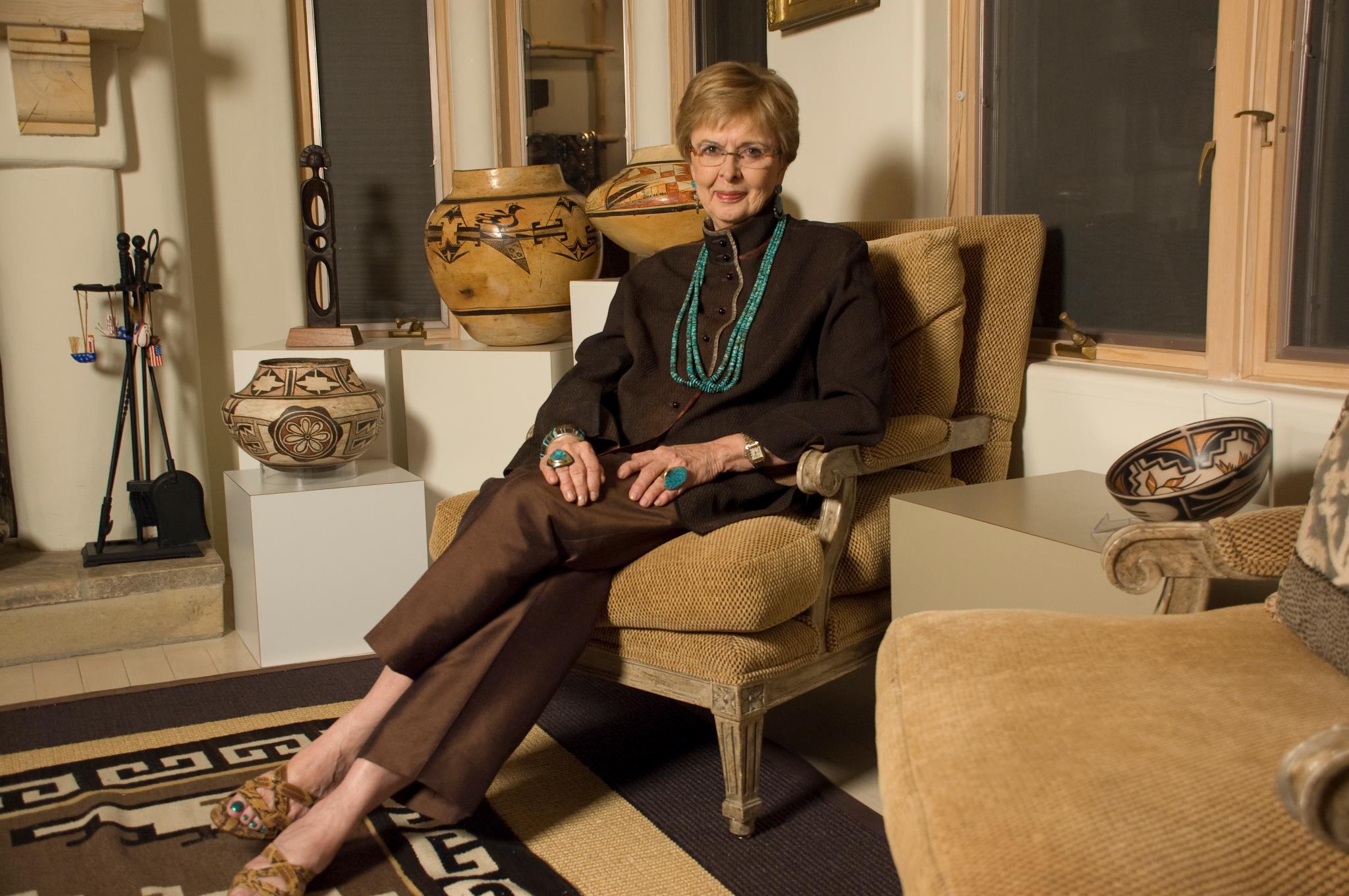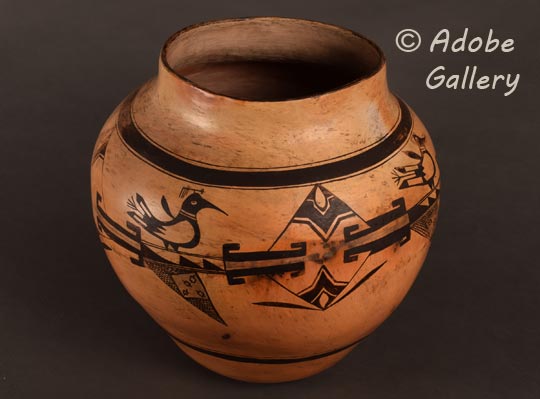Very Large Historic Polychrome Pictorial Hopi Pueblo Pottery Storage Jar
+ Add to my watchlist Forward to Friend
Forward to Friend
- Category: Historic
- Origin: Hopi Pueblo, Hopituh Shi-nu-mu
- Medium: clay, pigment
- Size: 16-1/2” height x 16-1/4” diameter
- Item # 25994
- Price Available On Request
Unveiling the Maker: The Mystery of a Hopi Pueblo Pottery Storage Jar
When a magnificent Hopi Pueblo pottery jar surfaces, the temptation is to try to assign the name of the maker. Most often, there are clues that lead one to select a maker—clues such as vessel shape, certain design elements, and age, perhaps—but it is not always so clear cut. When this jar came to us, our first guess was that it could have been made by Daisy Hooee Nampeyo (1920-1990), daughter of Annie Healing Nampeyo and granddaughter of Nampeyo, however we now believe it dates too early to have been made by her.
Daisy is known for having made large vessels, as is Nampeyo, however, this one does not have the attributes of the work of Nampeyo or her daughter Annie Healing or may not be late enough to have been made by Annie’s daughter Daisy. Unfortunately, there are not many Daisy’s pottery items published by which to make comparisons. Our thoughts that Daisy could have made it were based solely on the large size, but when we realized she was born in 1920, and decided the jar probably dates to circa 1920, that would eliminate Daisy as the maker. In the end, the name of the maker would be subjective and not particularly important.
We must discuss and analyze this magnificent jar on its own merits. We have already stated that it is large—larger than 16 x 16 inches—and this is not an easy feat to accomplish. After such a large jar is made and the design placed on, it must be fired, and that is where the danger lies. The jar must heat evenly, or it could break or crack. To accomplish an even heat as the fire is started is quite problematic on a jar of this size.

The design selected by the potter is perfect for such a large pottery vessel. It is simple and uncluttered yet complicated and compact. There are large diamonds outlined in dark brown pigment, each of which has a dark brown design located at the top and bottom. The left and right points of the diamond have chain-like hooked elements that connect each diamond to a platform on which sits a bird—not just a bird, but a magnificent bird. Each bird has a long beak, like that of a hummingbird, and each has a line-drawing on its head that is probably representing a crown of feathers. The tail feathers also are elaborate with line drawings that perhaps represent fluff feathers.
The pedestal on which the bird rests has a large triangle appended that is filled with cross hatch lines except for a square that contains four small elements. There are four diamonds and four birds. There are wide framing lines at the neck and near the base. The wide line at the neck is enclosed with a pair of thin framing lines. The wide framing line near the base has only a single thin framing line accompanying it. The jar is extremely thin. It has a slightly rounded bottom, typical of storage jars. The widest point of the body is about two thirds of the way up from the bottom.
Condition: this Very Large Historic Polychrome Pictorial Hopi Pueblo Pottery Storage Jar is in good condition. One section of the design is somewhat weak, and the opposite side is quite strong. I have been told that at one time in the past, some owner had the weak design over-painted to enhance its strength. That over-paint has been removed so that the jar is back to its original condition.
Provenance: we have a copy of a photograph of former Chicago gallery owner, and Santa Fe Indian art dealer, Marti Struever, with this jar sitting on a pedestal behind her. I have been told by a client that this jar was sold years ago at Bonham’s Auction in San Francisco, and it was, at that time, attributed to Nampeyo. In consultation with another client, friend, and appraiser, I was told that this was not made by Nampeyo or her daughter Annie Healing. So, we have opinions on who did not make the jar, but no expert opinion on who did make it.
Image SOURCE of Martha Hopkins Struever at her home in Santa Fe in 2008 is from her Facebook page.
Recommended Reading:
- THE CALL OF BEAUTY Masterworks by Nampeyo of Hopi by Edwin L. Wade and Allan Cooke
- Canvas of Clay: Seven Centuries of Hopi Ceramic Art by Edwin L. Wade and Allan Cooke
TAGS: Daisy Hooee Nampeyo, Annie Healing Nampeyo, Nampeyo of Hano, pottery, Hopi Pueblo, Martha Hopkins Struever

- Category: Historic
- Origin: Hopi Pueblo, Hopituh Shi-nu-mu
- Medium: clay, pigment
- Size: 16-1/2” height x 16-1/4” diameter
- Item # 25994
- Price Available On Request
Adobe Gallery Recommended Reading
Adobe Gallery Recommended Items
If you are interested in this item, we would also like to recommend these other related items:



